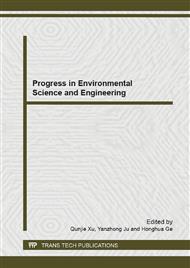p.1091
p.1099
p.1103
p.1109
p.1113
p.1117
p.1121
p.1126
p.1130
Online Determination of Anionic Surfactant in Environmental Water
Abstract:
It was found that ethyl violet can react with sodium dodecyl benzene sulfate (SDBS) to form ion associates in pH 2.2 ~ 2.8 of buffer solution of potassium hydrogen phthalate and hydrochloric acid in the presence of polyvinyl alcohol. Based on this, a method was proposed for online determination of anionic surfactant in environmental waterby. Under the optimum experimental conditions, Beers law was obeyed in the concentration range of 80 µg/L ~ 3500 µg/L of anionic surfactant (SDBS). The relative standard deviation of 2.1% was was obtained by injecting 800 µg/L of sodium dodecyl benzene sulfate standard solution (n=10). The detection limit calculated from three times of the average background noise was 4.39 µg/L. The proposed method had been applied successfully to the determination of anionic surfactant in environmental water and the results showed good agreement with that of the standard method.
Info:
Periodical:
Pages:
1113-1116
Citation:
Online since:
December 2012
Authors:
Keywords:
Price:
Сopyright:
© 2013 Trans Tech Publications Ltd. All Rights Reserved
Share:
Citation:


